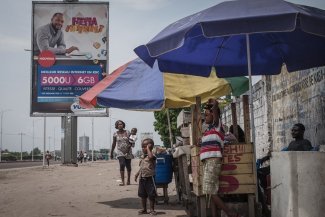Snapshot capturing a moment of tension during the ENM (National Women’s Meeting) in Mar del Plata, Argentina, 2010.
The awakening came to the surface from one day to the next, and it came with urgency, but it had been simmering on a low flame for decades. On 3 June 2015, the date of the first Ni Una Menos protest, Argentinian women took the reigns of a tectonic movement that would spread to dozens of countries, with an incontestable rallying cry born out of a brutal femicide: “stop killing us.”
The following year, on 3 June, Ni Una Menos was consolidated as a symbol of a revitalised women’s movement, which burst its banks and became international, weaving networks of sisterhood between women across the whole of Latin America, until it became the most repeated chant in the ever more frequent demonstrations.
“Look out, look out, look out, feminist women are making their way across Latin America. Tremble, tremble, tremble machistas, the whole of Latin America is going to be feminist.”
The tremor was felt across the world, and was particularly strong in the United States (on 21 January) when women forcefully responded to the misogyny of their president, Donald Trump.
The success of the first Ni Una Menos took everyone by surprise, but it was made possible by decades of activism, a process of accumulation, as demonstrated, most notably, by the 31 years of National Women’s Meetings (ENM), the latest edition of which was attended by 90,000 women.
Like the mass demonstration on this 8 March, in Buenos Aires, the ENM marches often end with controversial altercations in front of the cathedral (with episodes of police repression and “arbitrary” detentions on this occasion, according to the women’s groups, which have denounced a “woman hunt”).
When the silence was broken
Ni Una Menos was, above all, a communication tool, organised by feminist journalists, who managed to give visibility to a reality as monstrous as it is pervasive: a woman is killed every 30 hours in Argentina, simply for being a woman. But it was also an attempt to highlight the chain of continuity going from harassment on the street, the pay gap or everyday micro-machismo to rape and femicide.
The figures are unreliable because, until now, Latin American states had not taken the trouble to compile statistics on this silent war that the Brazilian anthropologist Rita Segato calls “femigenocide”.
In Argentina, it is feminist organisations such as MuMaLa that publish the femicide figures: 322 women were murdered in Argentina in 2016, by a partner or ex-partner in 66 per cent of the cases.
The situation is no more heartening in the rest of the continent. Brazil comes fifth in the global list of countries where the most women are killed: 4,762 women, or the equivalent of 13 women every day, were killed in 2013. In Honduras, despite its limited size, 531 femicides were perpetrated in 2014. In El Salvador, there were 230. A silent and deadly trickle.
Until the silence was broken. Just days after returning from the last National Women’s Meeting, Argentinian women learnt that, whilst they were demonstrating in the streets of Rosario, 16-year-old Lucía, had been tortured, raped and murdered in Mar del Plata.
She died from the pain, impaled, torn. Women in Argentina organised the demonstration of 19 October, Black Wednesday, within hours. And then continued to mobilise: they called an unprecedented strike on 25 November, which was echoed in dozens of countries.
On 26 November, Ecuador held its first national march against femicide. And women in Colombia came together under the hashtag #rompeelsilencio (break the silence), organising a mass donation of shoes, representing the vacuum left by women who are killed.
The idea was to “show that the mere fact of being women puts us at a much higher risk of being killed, and that something so grave and inconceivable is perceived as normal”, to quote María Isabel Covaleda, who inspired the movement.
Feminist and popular internationalism
“It was amazing how it spread, but it was thanks to the groundwork that had been underway around the country and had been simmering on a low flame,” explains academic Verónica Gago. New alliances are being forged both inside and outside the country and are gradually taking shape, albeit in a manner that experts in international relations may struggle to categorise.
“We are seeing the emergence of a type of internationalism combined with popular forces that is very powerful, with a way of building alliances that is not vertical,” says Gago.
And, to paraphrase Emma Goldman, the revolution Latin American women want is “to the rhythm of dance”. The experiences are diverse and combine political protest with art and entertainment. As the Chilean rapper, Anita Tijoux, recalls in Antipatriarca : “I won’t be the one who obeys / Because my body belongs to me.”
Or as highlighted by the various black and ‘peripheral’ feminists who, after years of straightening their hair because they had been made to believe theirs was unattractive, discover that their indomitable curls are the best symbol of strength and freedom; or the provocative graffiti and performances of the Bolivian Mujeres Creando (Women Creating).
It is also the case of the hundreds of Afro-descendant women who, two years ago, formed the spectacular carnival bloc Ilú Obá de Min, which means ‘female hands playing the drums for Xango’ (God of Thunder) in the African language Yoruba.
“Many women say the drum gives strength. Every woman has her own motives. United, we take Ilú Obá on a journey across the world,” says one of the members of the formation, which pays tribute to a black woman every year.
Between the drums, the graffiti or the verses, they discover that very special something that happens when women come together; what the Mexican activists Raquel Gutiérrez calls “entre mujeres” (between women):
“Establishing spaces where they can meet, talk, support each other... The struggle is being shaded with new colours that are observing each other and are taking on very serious social problems such as intrafamily violence. The ‘between women’ phenomenon is proliferating in all struggles and all across Latin America’s social landscape.”
These informal but very real networks took shape in the call to action for 8 March, which resonated throughout the world. Paraguay was one example.
“This stoppage is in opposition to the patriarchy and the capitalism exploiting us. The strength and resistance of women are visible and they are marching ahead,” Paraguayan activist Alicia Amarilla Leiva, who was heading a national group of rural and indigenous working women, CONAMURI, told Página 12.
The challenge Rita Segato is presenting the movement reflects the magnitude of the task and the opportunity ahead of women in Latin America.
“I believe the mission of this 8 March is to reconstruct the way women do politics. Whilst in the 1960s, feminism said, ‘what’s personal is political’, the path I am proposing is not to translate the domestic into public terms but, rather, to ‘domesticate politics’, to de-bureaucratise it, to humanise it in domestic terms.”
Feminism reaches the grassroots
Latin American women are dancing, marching, letting down their hair, coming together to forge a feminist international that is taking on ever greater prominence in the working class neighbourhoods, among indigenous and Afro-descendant women, the poorer sections of society. It is, perhaps, the main feature of this new movement:
“Feminism used to meet with rejection in the working-class neighbourhoods; it was perceived as an ideology of the elites, linked to the middle class and academia. Now it seems that the discourse regarding violence against bodies has managed to take on a degree of the concerns in working-class neighbourhoods. And this sensitivity has penetrated social classes across the board,” says Verónica Gago.
Gabriela Olguin, head of El Adoquín, a cooperative of 400 street vendors, and of the CTEP (Confederation of Workers in the People’s Economy), explains it in these terms: “The entry of the working classes into the feminist movement is very gradual. The feminist discourse has been in the hands of cultured, educated progressives.
Feminism has been anti-Peronist. A class vision had been imposed on it until very recently. But if it wants to be a truly massive and transformative movement, feminism has to move forward with all women.
On the other side of the border, on the periphery of São Paulo, Helena Silvestre, leader of the grassroots movement Luta Popular, says:
“The capitalist world exploits us, oppresses us, packages us, labels us and sells us. It puts the guilt on women for the violence done to their bodies. Poor women, black women, indigenous women and LGBTI have, for centuries, been the most murdered, the most raped and abused, those who die the most from clandestine abortions, whilst the wealthier white women abort in the comfort of private clinics.”
But now, “Poor women – doubly exploited – are rising up against their situation. For black women, their history is a source of the strength they need to accept their hair and their place in the battle,’’ says Olguin.
“If capitalism thrives on fragmentation, we women need to do the contrary to fight it: we need to come together. Male violence is deeply embedded in our structures.”
In the words of Helena: “The world kills us when it converts us into tits and arses, when it denies us the right to retirement, when we have no home where we can bring up our children, when its makes us believe its prettier to have a thin nose and pinks lips.
’’The pains we have to bear are so many that we can only be strong if we unite, as working women.”










